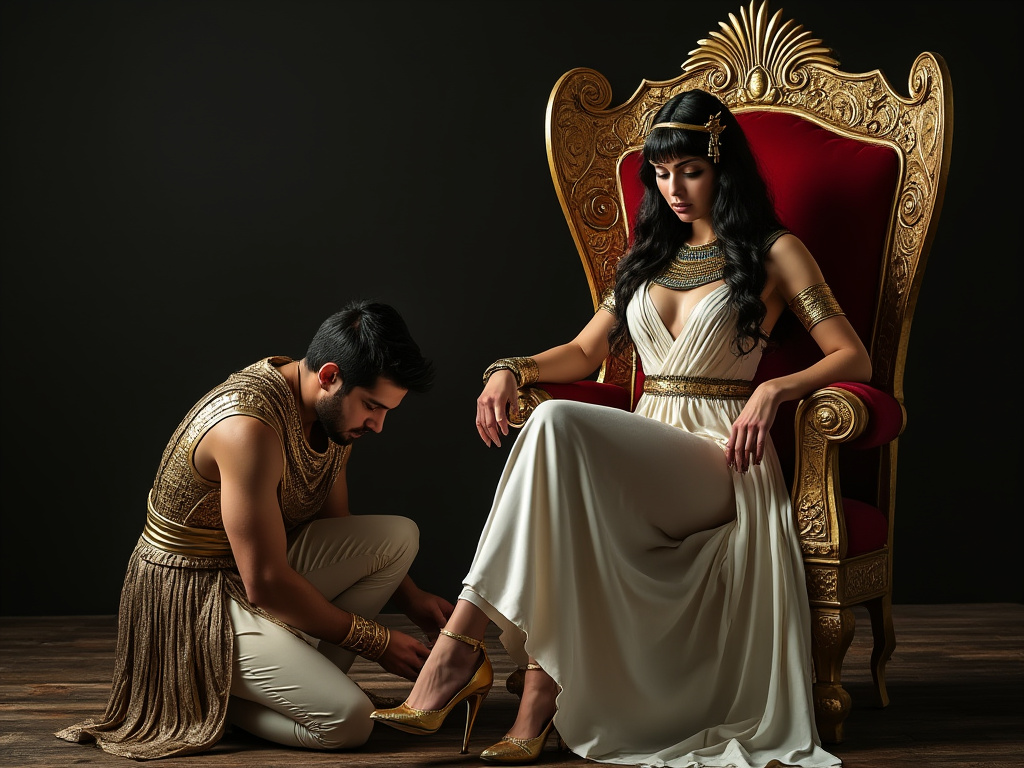The history of female Led Relationships is deeply woven with intriguing insights and influences that have evolved over time, reflecting societal shifts and the enduring allure of feminine authority. Although they may seem like a recent phenomenon, their roots go back centuries. FLRs are relationships where the woman takes the lead, often in decision-making, guiding both partners towards a shared vision for their lives. Today, they are gaining recognition as more people explore alternative relationship structures. However, the path to this acceptance has been winding and marked by cultural shifts, societal constraints, and evolving perspectives on gender roles.
In this post, we’ll explore the fascinating journey of female-led relationships, from their ancient origins to their modern resurgence.
Ancient Societies and Matriarchal Influence
Matriarchal Societies in Prehistoric Times
Archaeological research suggests that early human societies may have been matriarchal, with women playing a central role in leadership and social organization. In these societies, which were primarily agricultural, women were valued for their roles in fertility, nurturing, and agriculture. Women were thought to possess spiritual power and wisdom, often acting as healers, leaders, and decision-makers within their communities.
While it is difficult to generalize across prehistoric cultures, evidence of female deities and mother-goddess worship reflects the respect afforded to women in early human societies. These matriarchal structures are seen as the earliest examples of FLRs, with women wielding influence over families and clans.

Ancient Egypt and Powerful Female Leaders
In Ancient Egypt, women held higher status compared to other ancient civilizations. Egyptian queens like Cleopatra and Hatshepsut exemplified female leadership, wielding substantial influence and power. Although pharaohs were typically male, these women ascended to leadership roles, ruling in their own right and steering the direction of the empire. Their impact extended to both political and social spheres, demonstrating that female-led relationships were not only feasible but respected.
Cleopatra, in particular, was known for her relationships with Julius Caesar and Mark Antony, where she often led diplomatically and strategically. Her influence in these alliances highlights how powerful women led their relationships, asserting control in both personal and political domains.
Middle Ages to Early Modern Period: Women’s Roles Diminished
Shifts During the Middle Ages
The Middle Ages brought significant changes to gender roles in Europe. With the rise of organized religions such as Christianity, traditional family structures often placed men as heads of households, sidelining women’s authority. The perception of female subservience grew, shaping social norms and limiting women’s influence in relationships. Although women played essential roles within families and communities, their leadership was restricted, as religious and societal norms emphasized male dominance.
Female Sovereigns and Noblewomen
Despite these constraints, female-led relationships existed, particularly among the nobility. Noblewomen often managed estates and family affairs while their husbands were away in battle or diplomatic roles. Queens such as Elizabeth I of England and Isabella I of Castile demonstrated strong leadership, even if they often faced pressure to conform to patriarchal expectations. Elizabeth I, famously known as the “Virgin Queen,” maintained control over her life and kingdom, choosing not to marry in order to preserve her authority.
In certain European and Asian cultures, noblewomen wielded substantial influence and governed regions in their husbands’ or sons’ stead. These women demonstrated that female-led relationships and leadership could thrive under the right circumstances, even in the face of prevailing norms.

19th and 20th Centuries: Social Change and the Reemergence of FLRs
The Suffrage Movement and Changing Gender Dynamics
The 19th and early 20th centuries saw significant transformations in women’s rights, fueled by the suffrage movement and a push for equality in education, work, and voting rights. As women began to enter the workforce and fight for their autonomy, the dynamics of relationships started to shift. Women were no longer solely dependent on men, and this newfound independence allowed them to assert more influence in relationships.
FLRs began to resurface as women became financially independent and empowered to make decisions. The suffrage movement laid the groundwork for a broader reexamination of gender roles, which influenced relationship dynamics for years to come.

World War II and Women’s Expanded Role
World War II further accelerated this change. As men went to war, women took on roles that were previously male-dominated, from factory work to administrative jobs. This era marked a turning point in relationship dynamics, as women demonstrated their ability to lead and provide. After the war, many women retained their desire for independence, leading to new relationship structures where equality and female leadership were valued.
Modern Times: The Rise of Recognized FLRs
The Feminist Movement and Empowered Relationships
The feminist movement of the 1960s and 1970s played a crucial role in the resurgence of FLRs. With greater awareness and advocacy for women’s rights, traditional gender roles began to evolve, and many women started to explore new relationship models that offered them greater agency. This era saw an increased acceptance of non-traditional relationship structures, including female-led relationships where the woman played a more dominant role.
In an FLR, women may take the lead in managing finances, setting family goals, and even making decisions about career paths for both partners. By the late 20th century, FLRs were gaining acceptance as a legitimate and empowering choice for couples looking to redefine traditional roles.

Contemporary FLRs and Popularity in the 21st Century
oday, female-led relationships are more openly discussed and practiced. Social media, online communities, and resources on alternative relationship dynamics have contributed to their mainstream visibility. More couples are embracing FLRs, seeing them as a pathway to mutual respect, balance, and shared responsibility.
The rise of dual-income households and gender equality initiatives have further supported this relationship structure. Women are increasingly seen as capable leaders in both the workplace and the home, making FLRs an attractive option for many modern couples.
The history of female-led relationships is a testament to women’s resilience, strength, and adaptability across centuries. From ancient matriarchal societies to powerful queens and contemporary relationships, FLRs demonstrate how relationship dynamics can evolve to meet the needs of the time. Although the journey has been long and challenging, today’s couples have the freedom to explore relationship structures that best suit their values and lifestyles.
As society continues to embrace diverse perspectives on gender roles and relationships, FLRs will likely remain a significant option for couples seeking balanced, empowering partnerships. The resurgence of FLRs reflects broader social changes, paving the way for relationships that prioritize respect, agency, and shared decision-making.
What is a female-led relationship?
A female-led relationship is a relationship dynamic in which the woman takes the lead in decision-making, setting goals, and managing various aspects of the partnership.
Are FLRs a new trend?
No, FLRs have historical roots and can be traced back to ancient societies where women played central leadership roles.
Do FLRs work for everyone?
FLRs may not suit every couple, as they require mutual respect and clear communication. However, they are an empowering option for those who resonate with this dynamic.
How have FLRs evolved over time?
FLRs have evolved from matriarchal societies, through restrictive periods, to their resurgence in modern times, influenced by women’s rights movements and social changes.
What are the benefits of an FLR?
FLRs can create a balanced relationship, with shared responsibilities and a focus on mutual respect, autonomy, and personal growth.




